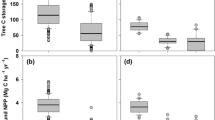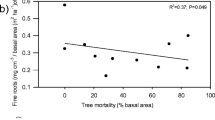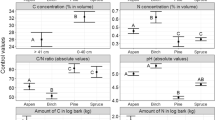Abstract
Masson pine stands infected by Pine wilt disease (PWD) in the Three Gorges Reservoir Region of central China were surveyed to quantify the immediate responses and subsequent trajectories of biomass, carbon (C), and nitrogen (N) in stand-level major ecosystem compartments. The biomasses of above- and belowground tree components, as well as of the understory, forest floor, and mineral soil (0–40 cm), were determined within each stand. C and N storage were also estimated for each ecosystem compartment. Overstory biomass decreased steadily with the extent of PWD infection. Understory biomass ranged from 1.97 to 4.16 Mg ha−1, and the observed value for forest floor biomass was 12.89–22.59 Mg ha−1. The highest mean C and N concentrations were found in the stem bark and needles of Masson pine, respectively, while the lowest were found in the semi- to fully decomposed layer of the forest floor and stem wood of Masson pine, respectively. The C and N storage of aboveground trees, tree roots, and the aboveground ecosystem decreased with the extent of PWD infection. However, the C and N contents of the understory, forest floor, and total mineral soil initially declined after PWD infection before recovering over the following several years. Those result concluded that the biomass, C, and N storage of different forest ecosystem compartments have experienced certain variations following the PWD epidemic. This is vital to understand the shifts in stand-level C and N allocation in PWD-damaged forest stands, as well as for predicting the responses of regional and global C and N cycling.






Similar content being viewed by others
References
Chai X, He Z, Li C, Tang L, Cheng S (1996) Studies on oviposition habit of the Japanese pine sawyer Monochamus alternatus Hope. J Beijing For Univ 19:69–73
Cohen AN, Carlton JT (1998) Accelerating invasion rate in a highly invaded estuary. Science 279:555–558
Covington WW (1981) Changes in forest floor organic matter and nutrient content following clear cutting in northern hardwoods. Ecology 62:41–48
Ding G, Wang P (2001) Study on change laws of biomass and productivity of masson pine forest plantation II. Biomass and productivity of stand at different ages. For Res 15:54–60
Dixon RK, Solomon A, Brown S, Houghton R, Trexier M, Wisniewski J (1994) Carbon pools and flux of global forest ecosystems. Science 263:185–190
Edburg SL, Hicke JA, Lawrence DM, Thornton PE (2011) Simulating coupled carbon and nitrogen dynamics following mountain pine beetle outbreaks in the western United States. J Geophys Res 116:G04033. doi:10.1029/2011JG001786
Frost CJ, Hunter MD (2004) Insect canopy herbivory and frass deposition affect soil nutrient dynamics and export in oak mesocosms. Ecology 85:3335–3347
Fujihara M (1996) Development of secondary pine forests after pine wilt disease in western Japan. J Veg Sci 7:729–738
Fujihara M, Hada Y, Toyohara G (2002) Changes in the stand structure of a pine forest after rapid growth of Quercus serrata Thunb. For Ecol Manag 170:55–65
Gandhi KJ, Herms DA (2010) Direct and indirect effects of alien insect herbivores on ecological processes and interactions in forests of eastern North America. Biol Invasions 12:389–405
Gao P, Wang B, Geng GG, Zhang GC (2013) Spatial distribution of soil organic carbon and total nitrogen based on GIS and geostatistics in a small watershed in a hilly area of northern China. PLoS ONE 8:e83592
Gao RH, Shi J, Huang RF, Wang Z, Luo YQ (2015a) Effects of pine wilt disease invasion on soil properties and Masson pine forest communities in the Three Gorges reservoir region, China. Ecol Evol 5:1702–1716
Gao RH, Song DW, Huang RF, Shi J, Luo YQ, Chen JY (2015b) Characteristics of typical Masson pine community and soil properties at the early invasive stage of pine wood nematode in the Three Gorges Reservoir Region of central China. J Beijing For Univ 37:84–91
Hicke JA, Asner GP, Randerson JT, Tucker C, Los S, Birdsey R, Jenkins JC, Field C (2002) Trends in North American net primary productivity derived from satellite observations, 1982–1998. Global Biogeochem Cycles 16:2-1–2-14
Houghton RA (2007) Balancing the global carbon budget. Annu Rev Earth Planet Sci 35:313–347
Hu G, Xu X, Wang Y, Lu G, Feeley KJ, Yu M (2012) Regeneration of different plant functional types in a Masson pine forest following pine wilt disease. PLoS ONE 7:e36432
Jandl R, Lindner M, Vesterdal L, Bauwens B, Baritz R, Hagedorn F, Johnson DW, Minkkinen K, Byrne KA (2007) How strongly can forest management influence soil carbon sequestration? Geoderma 137:253–268
Jenkins JC, Aber JD, Canham CD (1999) Hemlock woolly adelgid impacts on community structure and N cycling rates in eastern hemlock forests. Can J For Res 29:630–645
Jeong J, Kim C, Lee KS, Bolan NS, Naidu R (2013) Carbon storage and soil CO2 efflux rates at varying degrees of damage from pine wilt disease in red pine stands. Sci Total Environ 465:273–278
Johnson DW, Todd D, Tolbert VR (2003) Changes in ecosystem carbon and nitrogen in a loblolly pine plantation over the first 18 years. Soil Sci Soc Am J 67:1594–1601
Kim C, Jang KS, Kim JB, Byun JK, Lee CH, Jeon KS (2010) Relationship between soil properties and incidence of pine wilt disease at stand level. Landsc Ecol Eng 6:119–124
Kurz WA, Dymond CC, Stinson G, Rampley GJ, Neilson ET, Carroll AL, Ebata T, Safranyik L (2008) Mountain pine beetle and forest carbon feedback to climate change. Nature 452:987–990
Li X, Yi MJ, Son Y, Park PS, Lee KH, Son YM, Kim RH, Jeong MJ (2011) Biomass and carbon storage in an age-sequence of Korean pine (Pinus koraiensis) plantation forests in central Korea. J Plant Biol 54:33–42
Litton CM, Ryan MG, Knight DH (2004) Effects of tree density and stand age on carbon allocation patterns in postfire lodgepole pine. Ecol Appl 14:460–475
Lorenz K, Lal R (2010) Carbon sequestration in forest ecosystems. Springer, Dordrecht
Morehouse K, Johns T, Kaye J, Kaye M (2008) Carbon and nitrogen cycling immediately following bark beetle outbreaks in southwestern ponderosa pine forests. For Ecol Manag 255:2698–2708
Noh NJ, Son Y, Lee SK, Seo KW, Heo SJ, Yi MJ, Park PS, Kim RH, Son YM, Lee KH (2010) Carbon and nitrogen storage in an age-sequence of Pinus densiflora stands in Korea. Sci China Life Sci 53:822–830
Noh NJ, Kim C, Bae SW, Lee WK, Yoon TK, Muraoka H, Son Y (2013) Carbon and nitrogen dynamics in a Pinus densiflora forest with low and high stand densities. J Plant Ecol 6:368–379
Peichl M, Arain MA (2006) Above- and belowground ecosystem biomass and carbon pools in an age-sequence of temperate pine plantation forests. Agric For Meteorol 140:51–63
Peichl M, Arain MA (2007) Allometry and partitioning of above-and belowground tree biomass in an age-sequence of white pine forests. For Ecol Manag 253:68–80
Pfeifer EM, Hicke JA, Meddens AJ (2011) Observations and modeling of aboveground tree carbon stocks and fluxes following a bark beetle outbreak in the western United States. Global Change Biol 17:339–350
Schultz JC, Baldwin IT (1982) Oak leaf quality declines in response to defoliation by gypsy moth larvae. Science 217:149–151
Shi J, Luo YQ, Song JY, Wu HW, Wang L (2007) Traits of Masson pine affecting attack of pine wood nematode. J Integr Plant Biol 49:1763–1771
Shi J, Luo YQ, Wu HW, Yan XS, Jiang P (2009) Impact of invasion of pine wood nematode on the growth of dominant shrub Pleioblastus amarus in Pinus massoniana communities. For Stud China 11:61–63
Spiegel KS, Leege LM (2013) Impacts of laurel wilt disease on redbay (Persea borbonia (L.) Spreng.) population structure and forest communities in the coastal plain of Georgia, USA. Biol Invasions 15:2467–2487
Swank W, Waide J, Crossley JD, Todd R (1981) Insect defoliation enhances nitrate export from forest ecosystems. Oecologia 51:297–299
Tao LC, Meng XQ, Sun C, Liu QJ (2014) Storage of litter and coarse woody debris of Pinus tabulaeformis plantation in Beijing. J Fujian Coll For 34:26–32
Taylor AR, Wang JR, Chen HY (2007) Carbon storage in a chronosequence of red spruce (Picea rubens) forests in central Nova Scotia, Canada. Can J For Res 37:2260–2269
Vesterdal L, Schmidt IK, Callesen I, Nilsson LO, Gundersen P (2008) Carbon and nitrogen in forest floor and mineral soil under six common European tree species. For Ecol Manag 255:35–48
Wan F, Zheng X, Guo J (2005) Biology and management of invasive alien species in agriculture and forestry. Science Publication, Beijing, pp 14–19
Yanai RD, Arthur MA, Siccama TG, Federer CA (2000) Challenges of measuring forest floor organic matter dynamics: repeated measures from a chronosequence. For Ecol Manag 138:273–283
Yu M, Xu X, Ding P (2011) Economic loss versus ecological gain: the outbreaks of invaded pinewood nematode in China. Biol Invasions 13:1283–1290
Zai JZ, Chen YL (1992) The distributing characteristic and control methods on pine wood nematode in Xiangshan county. J Zhejiang For Sci Technol 12:22–25
Zeng LX, Wang PC, Xiao XF, Wan R, Huang ZL, Pan L (2008) Allocation of biomass and productivity of main vegetations in Three Gorges reservoir region. Scientia Silvae Sinicae 44:16–22
Zhao BG, Futai K, Sutherland JR, Takeychi Y (2008) Pine wilt disease. Springer, Tokyo, pp 202–203
Zhao JL, Kang FF, Wang LX, Yu XW, Zhao W (2014) Patterns of biomass and carbon distribution across a chronosequence of Chinese pine (Pinus tabulaeformis) forests. PLoS ONE 9:e94966
Acknowledgements
Authors gratefully acknowledge the support from the Hubei Academy of Forestry and Station of Pest and Disease Control and Quarantine of Yiling District, Yichang city, and they are Jingyuan Chen, Chenghao Hong, Dewen Song, and Honggao Liu.
Author information
Authors and Affiliations
Corresponding author
Additional information
Project funding: This study was supported by Special Fund for Forest Scientific Research in the Public Welfare (201204501); National Natural Science Foundation of China (31170613) and Beijing Higher Education Young Elite Teacher Project (YETP0740).
The online version is available at http://www.springerlink.com
Corresponding editor: Hu Yanbo.
Rights and permissions
About this article
Cite this article
Gao, R., Luo, Y., Wang, Z. et al. Patterns of biomass, carbon, and nitrogen storage distribution dynamics after the invasion of pine forests by Bursaphelenchus xylophilus (Nematoda: Aphelenchoididae) in the three Gorges Reservoir Region. J. For. Res. 29, 459–470 (2018). https://doi.org/10.1007/s11676-017-0432-5
Received:
Accepted:
Published:
Issue Date:
DOI: https://doi.org/10.1007/s11676-017-0432-5




